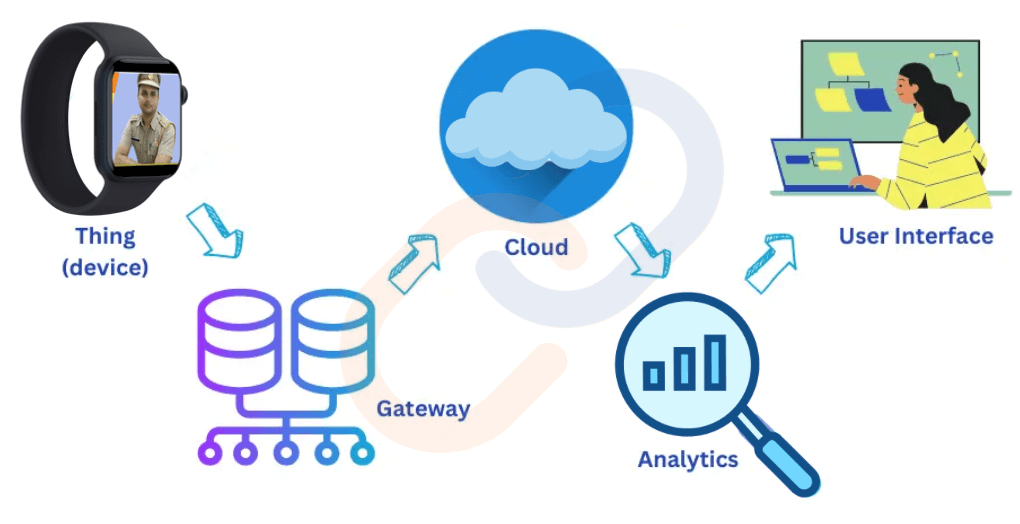Internet of Things In the subject Technology, the topic Internet of Things (IoT) refers to a network of physical devices connected through the internet. These smart devices collect and share data, making everyday tasks easier and more efficient.
Internet of Things
Definition: The Internet of Things (IoT) is a network of interconnected devices, sensors, and systems that communicate with each other and exchange data over the internet to perform specific tasks without direct human intervention.
Examples:
- Smart Homes: Thermostats, lighting, and security systems (e.g., Nest, Ring).
- Healthcare: Wearable devices that monitor health metrics (e.g., Fitbit).
- Industrial IoT (IIoT): Predictive maintenance for machinery.
- Agriculture: Sensors for soil moisture and weather data.
- Smart Cities: Traffic management, waste collection, and energy conservation.
Characteristics of IoT (Internet of Things)
- Connectivity → Devices connected via networks (Wi-Fi, Bluetooth, etc.) to share data. Example: Smart home devices like lights communicate via Wi-Fi.
- Interoperability → Devices work together, regardless of manufacturer. Example: Different smart bulbs controlled by the same app.
- Automation and Control → Devices perform tasks without human intervention. Example: Smart thermostat adjusts temperature automatically.
- Data Collection and Analysis → Devices gather real-time data for insights. Example: Wearable devices track health metrics.
- Remote Monitoring and Management → Devices monitored and controlled from anywhere. Example: Security cameras controlled via mobile apps.
- Scalability → Easy to add more devices to the system without disruption. Example: More sensors added to a factory without affecting operations.
- Real-Time Communication → Instant data updates for quick decisions. Example: Smart agriculture systems trigger irrigation in real-time.
- Efficiency and Optimization → Intelligent decisions to maximize resource use. Example: Smart grids optimize electricity usage based on demand.
- Security and Privacy → Ensures data protection through encryption and secure access.
Example: Health data secured with encryption protocols. - Cost Efficiency → Reduces costs by automating processes and optimizing resources. Example: Smart buildings save energy by adjusting systems automatically.
Core Components of IoT

Sensors and Actuators
- Sensors: Collect data (e.g., temperature, motion).
- Actuators: Perform actions based on sensor data (e.g., turning on a fan).
b. IoT Gateway
- Acts as a bridge between devices and the cloud.
- Translates protocols and filters data.
c. Network Connectivity
- Technologies: Wi-Fi, Bluetooth, Zigbee, cellular networks.
d. Cloud/Edge Computing
- Cloud: Centralized storage and processing of data.
- Edge: Decentralized processing closer to the data source.
e. IoT Platforms
- Examples: AWS IoT, Google Cloud IoT, Microsoft Azure IoT Hub.
f. Applications
- The interface users interact with to control devices or analyze data.
The IoT Data Flow:
- Step 1: Devices (sensors, actuators, or smart devices) collect data from the environment.
- Step 2: Data is transmitted over the network to a central processing unit (cloud or edge server).
- Step 3: The data is processed and analyzed for meaningful insights or decisions.
- Step 4: Actions are taken based on the analysis (e.g., sending a notification to the user, adjusting smart home temperature, or activating machinery).
Applications of IoT
| Sector | Applications | |
| Smart Homes | Smart Appliances: IoT-enabled refrigerators, washing machines, surveillance cameras, smart locks and thermostats.Voice Assistants: Alexa and Google Assistant control home devices.Example: IoT startups like Smartron are innovating in smart home tech.Wipro Lighting offers IoT-enabled smart lighting solutions; Godrej Smart Locks for home security. | |
| Healthcare | Wearable Devices: Fitness trackers like Fitbit monitor heart rate, sleep patterns, and physical activity.Remote Patient Monitoring and Telemedicine: IoT devices like glucometers and blood pressure monitors send real-time data to doctors.Smart Pills: Pills with embedded sensors that monitor medication adherence.Example: AIIMS utilizes IoT-based systems for patient data tracking. | |
| Agriculture | Precision Farming: IoT-enabled sensors monitor soil moisture, temperature, and crop health.Automated Irrigation: Smart irrigation systems operate based on weather and soil data.Example: Microsoft’s AI-IoT collaboration for yield prediction in India, KissanRaja automates irrigation, IoT-driven greenhouses | |
| Transportation | Fleet Management: IoT devices monitor vehicle health and optimize routes.Public Transport: Real-time tracking of buses and trains.Example: Indian Railways uses IoT for monitoring track conditions and train schedules; Ola Cabs for fleet management; Delhi Traffic Police uses IoT for traffic flow control. | |
| Industrial IoT | Factory automation and Predictive Maintenance: Sensors on machinery detect wear and tear to schedule maintenance.Cobots (Collaborative Robots): Work alongside humans in manufacturing processes.Example: Tata Steel and Reliance Industries use IoT for production and pipeline monitoring. | |
| Energy Management | Smart Grids: Optimize electricity distribution and consumption.IoT in Renewable Energy: Monitoring solar panel efficiency or wind turbine performance.Example: Solar Energy Corporation of India uses IoT for renewable energy management. | |
| Smart Cities | Traffic Management: Sensors monitor and manage real-time traffic flow (e.g., adaptive traffic lights).Waste Management: IoT-enabled bins signal waste collection schedules.Public safety management: Surveillance cameras Indian Example: Pune’s smart street lighting adjusts brightness using real-time data; Bhubaneswar (smart lighting, waste management) under Smart Cities Mission. | |
| Environment | Pollution tracking: Air and water quality monitoring, forest fire detection.IoT devices for wildlife monitoring.Example: IoT-driven water sensors in the Ganga River. | |
| Retail | Smart Shelves: Automatically detect low inventory levels and reorder products.Customer Behavior Analysis: IoT-based cameras track shopper movements for better store layouts.Example: Amazon Go stores with checkout-free shopping using IoT. | |
| Disaster Management | Early detection and response to natural disasters like floods and earthquakes.Example : Google AI-IoT systems predicting floods in Bihar, India. | |
Benefits of IoT
- Improved Efficiency and Productivity → Automates tasks and enables real-time monitoring for better operations.
Examples:- IoT sensors in manufacturing prevent downtime by detecting issues.
- Smart homes automate daily tasks like temperature adjustments
- Railways uses IoT for predictive maintenance to reduce delays.
- Cost Savings → Optimizes resources and prevents waste to save money.
Examples:- Smart irrigation conserves water, cutting costs.
- Tata Power uses IoT in smart grids to lower energy losses.
- Better Decision-Making → Real-time data collection improves decision quality.
Examples:- IoT in farming aids data-driven crop decisions.
- Enhanced Safety and Security → Ensures safety with surveillance and hazard detection.
Examples:- IoT security systems provide automated alerts.
- Healthcare devices monitor patient vitals for emergencies.
- Bangalore Smart City employs IoT surveillance for public safety.
- Environmental Benefits → Reduces waste and conserves resources.
Examples:- Smart meters track and reduce electricity use.
- Efficient irrigation minimizes water consumption.
- Improved Customer Experience → Delivers personalized and seamless user experiences.
Examples: Amazon Alexa offers customized recommendations. - Global Connectivity: Bridges physical and digital worlds.
Challenges in IoT
A. Security and Privacy Concerns
- IoT devices are vulnerable to cyberattacks and unauthorized access.
- Examples: Mirai Botnet Attack (2016): Exploited unsecured IoT devices for DDoS attacks.
B. Data Management Challenges
- IoT generates massive data that’s hard to store, process, and analyze.
- Examples: Smart cities produce petabytes of real-time traffic and environmental data.
C. Connectivity Issues
- IoT depends on reliable internet, often lacking in rural areas.
D. High Costs of Implementation
- IoT requires significant upfront investment.
- Examples: High setup costs for sensors, gateways, and analytics platforms.
E. Lack of Standardization
- Proprietary protocols lead to interoperability challenges.
- Examples: Smart home devices from different brands face compatibility issues.
F. Scalability Challenges
- Managing many devices is complex with limited bandwidth and storage.
G. Ethical and Legal Challenges
- IoT raises concerns about surveillance and unclear regulations.
- Examples: Surveillance concerns in public spaces using IoT.
H. Environmental Impact
- IoT contributes to e-waste and energy consumption.
I. Cultural and Skill Barriers
- Resistance to technology and lack of expertise hinder IoT adoption.
In 2022, in order to secure Consumer Internet of Things (IoT) devices, the Department of Telecommunications has released a report “Code of Practice for Securing Consumer Internet of Things(IoT)”.
IoT in India
Overview of IoT Growth in India:
- Projections: The Indian IoT market is expected to reach $15 billion by 2025, with applications in sectors like healthcare, agriculture, and smart cities.
Government Initiatives Supporting IoT:
- Digital India Mission 2015:
- Focuses on integrating IoT to improve governance and public services.
- Draft IoT Policy 2015
- Aims to create a robust IoT ecosystem in India.
- Focuses on developing IoT-based systems for sectors like health, agriculture, transportation, and smart cities.
- Smart Cities Mission (2015)
- Develops 100 smart cities using IoT technologies to improve urban living through smart transportation, energy, healthcare, and public services.
- National Digital Communications Policy 2018
- Emphasizes IoT as a key driver of digital transformation, aiming to boost innovation, connectivity, and economic growth.
- Center of Excellence
- MeitY-Nasscom CoE – IoT & AI: NASSCOM, in collaboration with the Department of Electronics and Information Technology (DeitY), has established CoEs to foster IoT innovation.
- Centre of Excellence in Intelligent IoT Sensors (2023): Launched by MeitY in 2023 in Kerala. It Focuses on developing advanced IoT sensors and applications.
- IoT Research Initiative by DST
- Initiated by DST focusing on smart cloud, adaptive interfaces, and interconnection of smart devices.
- National Policy on Electronics (NPE) 2019
- This policy provides a framework for the growth of the electronics and IoT sectors in India.
Key Applications of IoT in India:
- Agriculture:
- Example: IoT-based sensors for soil monitoring and precision farming in Karnataka’s “Bhoomi” initiative.
- eNAM (National Agriculture Market): Real-time data from IoT sensors can provide better insights into crop quality and market demand, leading to more accurate price discovery on the eNAM platform.
- Healthcare:
- Example: IoT-enabled wearable devices for remote health monitoring during COVID-19.
- Transportation:
- FASTag: IoT-enabled electronic toll collection system.
- Smart Traffic Management: Real-time traffic monitoring in cities like Delhi and Mumbai.
- Utilities:
- Smart meters for electricity and water usage optimization.
- IoT-based grid management in rural electrification projects.
- Industry:
- Predictive maintenance in manufacturing and logistics.
- Cobots (collaborative robots) in assembly lines.
Challenges Specific to India:
- Infrastructure Deficit: Limited high-speed internet in rural areas hampers IoT deployment.
- Cost Sensitivity: High costs of IoT devices deter small-scale adoption.
- Cybersecurity Concerns: Need for robust frameworks to secure IoT networks.
Indian Startups in IoT:
- Stellapps: IoT solutions for dairy management.
- TagBox: Cold chain monitoring using IoT.
- SenseGiz: IoT devices for tracking and security.
IoT (Internet of Things) vs IoE (Internet of Everything)
- IoT (Internet of Things) → Connection of physical devices (smartphones, appliances, wearables, etc.) via the internet to exchange data and automate processes.
- Focus: Devices and their communication.
- Examples: Smart home devices, wearables, connected vehicles.
- IoE (Internet of Everything) → Broadens IoT by connecting not just devices but people, data, and processes.
- Focus: Holistic integration of devices, people, data, and processes.
- Examples: Smart cities, integrated industrial ecosystems, connected healthcare.
| Aspects | IoT | IoE |
| Scope | Devices only | Devices + people + data + processes |
| Interaction | Device-to-Device | All-encompassing connection |
| Purpose | Automation | Holistic Intelligence and optimization |
